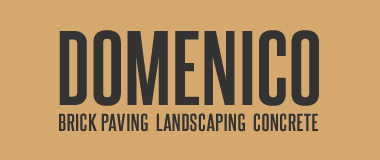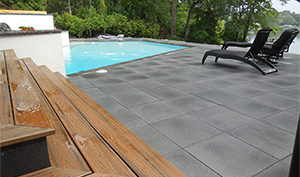Stamped Concrete
Is stamped concrete a good idea to use in Michigan with our wide temperature variations. Salt use and the freeze and thaw cycle can cause damage to many surfaces.

Stamped Concrete vs. Traditional Concrete
Stamped Concrete has some distinct advantages when compared to traditional concrete. The main advantage with stamped concrete is the wide availability of colors and patterns. To be sure, stamped concrete usually looks a lot more aesthetically appealing than traditional brushed concrete. If you’re 100% sold on concrete for your driveway, pathway, walkway, or patio, then stamped concrete is a nicer choice than traditional concrete. The cost is typically about 300% of what plain concrete costs. But the look is worth the additional price. So as far as concrete goes, stamped is a much nicer way to go.
Unfortunately, all concrete cracks over time. It’s inevitable. Concrete, by nature, is imperfect, and over time it’s prone to cracking. The only question is how soon and how badly will it crack. Which leads us to our next topic:
Stamped Concrete vs. Interlocking Pavers
When compared with interlocking concrete pavers, stamped concrete begins to lose the battle. If installed properly, there are almost no disadvantages with pavers. But in comparison, there are a lot of challenges with stamped concrete. Below we’ve outlined a comparison of the two.
Cracking
As mentioned before, stamped concrete behaves the same as the plain concrete on your city sidewalks and roadways. It’s prone to cracking. Pavers do not. And, if a paver is ever damaged, it’s simple to remove the affected paver and install a new one. The same is not possible with stamped concrete. A good friend once put it this way, “There are two kinds of concrete; Cracked Concrete and ‘Gonna Crack’ Concrete.” Unfortunately, that’s been our experience too.

Unsightly Control Joints
All concrete patios, driveway or pathways need control joints. These are the big, deep lines that are installed every 5 or 10 feet on every concrete job. They are installed in an effort to prevent cracking or, more specifically, to give the concrete a specific place to crack. The problem with control joints in stamped concrete is they completely ruin the façade that the use of stamped concrete is trying to accomplish. When you’re trying to make something look like tile or pavers or flagstone, a big gaping line going across the middle sort of ruins that look. With pavers, you never have that problem. Pavers naturally have joints everywhere. The look is preserved all the way through the patio or pathway. That cannot be true with stamped concrete. Look at these photos and judge for yourself.
Future Changes/ Additional
With stamped concrete, what you get is permanent. If you add on in the future, it won’t ever match up to the first batch that was installed years before. And there is no way to move or change stamped concrete. With pavers, you can change the shape, add more pavers, add a matching pathway, make the patio larger, whatever you want! Pavers are versatile, re-useable, and easy to add on to.
Repairs/ Ongoing Maintenance
Suppose a tree root grows underneath your patio in a few years and causes the patio to rise up and crack. Or suppose for some reason there was some settling or sinking in the ground under that patio. With stamped concrete, the damage is permanent; there will be no way to correct the issue and have the fix look the same as the original work.. But with pavers, you can easily dig up that area, fix the problem and re-install the pavers to look just like new.
To maintain that shiny bright appearance, stamped concrete must be re-sealed or recoated every two years, incurring maintenance costs. Additionally, the coating must be completely stripped every 2nd coat and re-applied on a clean base to avoid build up and the resulting cloudy look to the surface. This coating can present a slipping hazard when wet, which brings us to the next issue:
Slippery When Wet
Many stamped concrete patterns form the concrete into a smooth pattern on top. While this is pleasing to walk on, you’d better watch out when it rains! Stamped concrete is often very slippery when wet. Some stamped concrete contractors even install a scratch coat or sand coat into the surface to help mitigate this problem. But most do not. And they surely won’t tell you how you’ll be sliding around your patio or driveway if you ever have to walk or drive on it in the winter. This is not an issue with pavers. Pavers have a surface that is just perfect for pedestrian and vehicle traffic. Smooth enough to look and feel nice, but sturdy enough to have some grip when wet.
Durability, Stability, Dependability
If built to standards, Concrete Pavers have a compressive strength of 8,000-10,000 PSI or more. The compressive strength of concrete is typically only 3,000-4,000 PSI. That means pavers have a greater weight bearing capacity than concrete does. Which is important for any surface but particularly reassuring for your driveway.
Comparable in Cost
Sometimes pavers can add up to a slightly higher price tag. But that only reflects the initial investment price. Pavers are usually around the same price point – per square foot – as stamped concrete. Given that paver patios, walkways, and driveways are custom build and each piece is set in by hand, the overall value is much greater for pavers vs. stamped concrete.
Curing Time/ Curing Problems
You can walk on or drive on pavers the instant the job is finished. This is not true with concrete. There is a typically a curing time of 3-5 days before you can use concrete after it’s been installed. And although you may not be in that much of a rush, problems can arise during that curing time. Inclement weather, children or animals running across the concrete, vandals writing in the concrete before it cures, or dramatic changes in temperature overnight can cause the concrete to cure at different rates throughout the job. None of this is a concern with pavers. They’re completely finished and ready to use the moment they leave the factory.
Recycling Issues
Any concrete contractor worth his salt will install rebar in the concrete during construction. The downside of this is if the concrete is ever torn out and removed in the future, the recycling centers will not accept concrete with rebar inside of it. So the used concrete ends up in a landfill. Pavers are individual units. They are recyclable two different ways. First (and hopefully) you would just find someone who wants to use them for a new project. But if that is not an option, they are fully recyclable at any plant that accepts clean used concrete.
Variety/Selection
The average stamped concrete contractor will have maybe 5-15 different stamps available. Whereas the average paver contractor will have half a dozen different paver suppliers each with a dozen or so paver varieties and several color options in each variety. The options available in pavers significantly outweigh those in the stamped concrete market.
Imitation? Or the Real Thing?
Stamped concrete, by nature, is an imitation of something else. The stamp and coloring is typically trying to mimic tile, brick, pavers, bluestone, or flagstone. Given the similarity in cost, why wouldn’t you just go for the real thing? Concrete pavers come in all sorts of shapes an sizes, from flagstone to large tile to real cut stone to concrete interlocking pavers. If that the look you’re after, why not get the real thing?
We’ve made a decision here at Domenico Brick Paving and Landscape to not install stamped concrete for all the reasons above. There is almost no benefit to stamped concrete over pavers. The variety available in pavers these days is better than anything available in the stamped concrete market. Furthermore, we warranty all of our work for 5 years. Concrete is something we cannot warranty, We know it will probably crack within the first 5 years and there’s little we can do to prevent that. This is why you’ll probably never find a stamped concrete contractor that will warranty their work against cracking. And if you do, you’ll probably never find one that will offer a warranty that is greater than 1 year. There’s a reason for this. Stamped concrete looks much better when compared to regular, traditional concrete. But the better option is pavers. Call us today to see some samples of what we could do for your property!
Sealing
No sealer is required, but if you do prefer to seal the pavers you need to wait 2 months before having it applied.
We recommend a dry look sealer made by Techni-seal. There is no waiting time between paver installation and applying the sealer. It’s guaranteed to last 5 years (Field testing is ongoing. This product is still going strong after 8 years weathering.)
Wet look sealers need to be re-applied every 2 years or so. After the 2nd coating, before you apply a 3rd coat, you need to strip the sealer off the pavers. This can be a costly and environmentally hazardous operation. By using a dry look, water-based sealer you save up to 75% of the cost of stripping and reapplying the wet-look solvent based sealer over 6 years.
Polymeric Sand (polysand)
Using polymeric sand will almost guarantee no weed growth. Moss growth is inhibited except for areas that are moist or shady or both.




